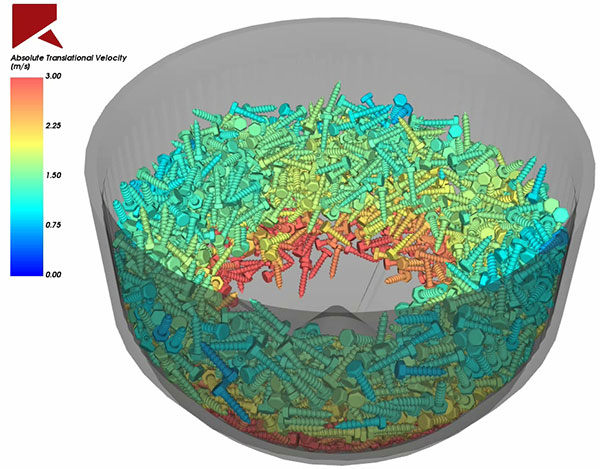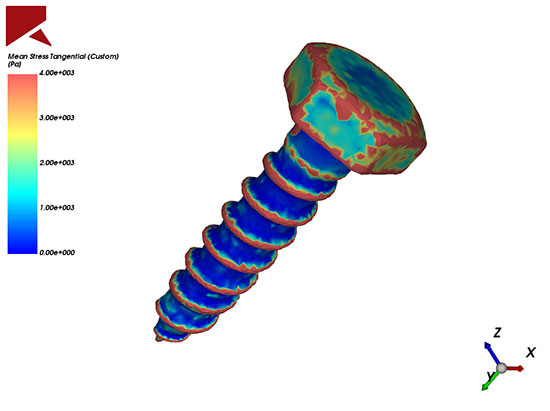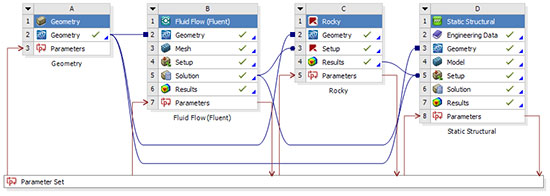Advanced Particle Simulation Software Updated
Highlights include enhanced particle collision analysis, fiber modeling improvements and expanded ANSYS Workbench integration.

ESSS reports that among the introductions in the new version 4.2 release of its Rocky DEM (discrete element method) high-fidelity particulate software is improved particle collision analysis. Shown here is a relevant intra-particle collision application that polishes metal parts in a tumbling machine. The pan holds 2,000 screws, and each screw has 10,000 triangles on its surface representation. Image courtesy of ESSS.
Latest News
February 6, 2019
ESSS (Engineering Simulation and Scientific Software) has announced the 4.2 release of its Rocky DEM (discrete element method) high-fidelity particulate simulation software. Rocky DEM 4.2, the company says, adds to and broadens its modeling capabilities. Among the key enhancements in version 4.2 cited by ESSS are improved particle collision analysis, spring and damper motion capabilities, improvements to fiber modeling and ANSYS Workbench integrated fluid–particle simulation.
Designers and engineers can use Rocky DEM to predict how collisions happen within a particle. Version 4.2 introduces intra-particle collision statistics such as duration, impact and shear that, the company says, add more value to its collision energy spectra. Using this statistical information can help designers accurately estimate particle abrasion, edge chipping and damage as well as help determine how collisions affect the system, ESSS explains.

Rocky DEM’s motion body dynamics kernel incorporates spring and damper motion capabilities designed to enable broader simulation while simplifying configuration and post-processing, ESSS says. Beginning with version 4.2, users no longer need to couple with external motion-body dynamic software to simulate complete models like passive valves and gates, independent multi-wheel suspensions, damped actuators and pre-tensioned systems, according to the company.
ESSS further reports that release 4.2 expands Rocky DEM's modeling range of real fibers and particles, and it further improves simulation speed. A new search algorithm is said to speed up packed-fiber system simulation by an average of two times. As well, users have the ability to configure different elastic ratios for each fiber segment.
Rocky DEM 4.2 offers more robust integration with the ANSYS Workbench simulation software platform when coupling with ANSYS Fluent CFD (computational fluid dynamics), ESSS says. The project schematic now shows on-the-fly simulation progress updates and robust multiple design-point projects, including CFD to DEM. ESSS adds that “seamless” ANSYS SpaceClaim and Rocky DEM geometry-unit handling enables simulations on different scales inside the same project schematic.

Other Rocky DEM 4.2 enhancements reported by ESSS include:
- Solid and porous media domains for fluid–particle–thermal setups provide tight coupling so that particles move through and between multiple fluid domains when coupling with ANSYS Fluent.
- CFD mesh decomposition functionality on multi-GPU (graphics processing unit) workstations, which ensures that a simulation run executes in parallel through a domain decomposition approach based on CFD mesh cells.
- Context save/restore functionality that eliminates the customization needed to compare differences in multiple simulations.
- A new particle generation preview that provides immediate feedback of estimated number of particles to be released into a system based on setup parameters.
- Custom output control capability that optimizes disk I/O and minimizes data storage issues so users can independently configure output frequency from simulation summary curves and particle results.
To learn more about Rocky DEM, visit ESSS.
Watch a storage silo simulation using Rocky DEM’s spring and damper motions capabilities.
Browse the Rocky DEM technical library for webinars and articles.
Request a free 30-day trial of Rocky DEM.
See why DE's Editors selected Rocky DEM 4.2 as their Pick of the Week.
Sources: Press materials received from the company and additional information gleaned from the company's website.
Subscribe to our FREE magazine, FREE email newsletters or both!
Latest News
About the Author
Anthony J. Lockwood is Digital Engineering’s founding editor. He is now retired. Contact him via [email protected].
Follow DERelated Topics
All topics



